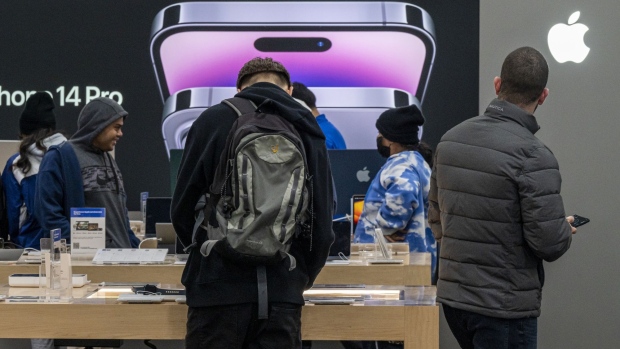Feb 14, 2023
Apple to Scrutinize Customer History for New ‘Buy Now, Pay Later’ Service
, Bloomberg News

(Bloomberg) -- With Apple Inc. pushing into the lending business with a “buy now, pay later” service, the company is laying out rules for how it will approve transactions. One key factor: whether you’ve been a good customer in the past.
The Apple Pay Later service — announced last year but still in the testing phase — will evaluate borrowers based on their spending history and even which of the company’s devices they own. The program, which lets shoppers make purchases and then pay over installments, also will look at whether customers have applied for an Apple Card credit card and the other cards they have linked to their Apple Pay accounts.
The offering is part of a broader push into financial services, which is seen as a big growth opportunity for the tech giant but also one with potential pitfalls. Already, the Pay Later service is running behind schedule: It was originally expected last year. The company also is working on a homegrown infrastructure for financial products that will help decrease its reliance on banking partners.
The lending criteria were revealed as part of a test of the service with Apple employees, who can now use the option for their own personal purchases. The evaluations determine whether the company is willing to lend money to applicants and how big an amount it will approve. Many testers are seeing loan approvals for $1,000 and under.
Apple Pay Later loan offers expire after 30 days and applications will sometimes require a copy of a government identification card, full social security number and two-step verification on an Apple account, according to the notes in the test version of the service. Loan status with Apple Pay Later won’t affect access to other company services.
A spokeswoman for Cupertino, California-based Apple declined to comment. Bloomberg originally reported on the company’s lending strategy last March.
Apple is counting on new services to help maintain growth, especially after a recent slowdown. The company posted disappointing holiday sales earlier this month, but gave a reassuring outlook to investors. And the shares have gained 18% this year.
- Read more: Apple rebounds as investors look past sluggish holidays
The new service will let Apple leverage its trove of data on customers, including their spending at company retail outlets, App Store transactions and services like Apple Cash peer-to-peer payments. Apple Pay, a mobile payment service launched in 2014, and the Apple Card, which debuted in 2019, have given the company an even closer connection to consumers’ financial lives.
The Pay Later system is integrated into the Wallet app on the iPhone and allows users to make an Apple Pay purchase over four installments during the following six weeks. When customers sign up, they’re asked to give an amount they would like to borrow and then the system comes back with an approved total — similar to the Spending Power feature for American Express cards.
The service marks the first time that the company is using an in-house payment platform and conducting lending itself. Apple created a business called Apple Financing LLC that will handle applications, lending and credit approvals. Still, Apple Card partner Goldman Sachs Group Inc. is the issuing bank, and the payment network provider is MasterCard Inc.
The Apple Pay Later documentation shows that transaction histories are stored with its financing subsidiary, Goldman Sachs and MasterCard — but not with Apple itself, for privacy reasons.
The company is gearing up to launch Apple Pay Later in the coming weeks after releasing the test to thousands of retail employees earlier this month. Before the expansion to retail staff, Apple had been trying out the program with corporate employees for several weeks.
(Updates with chart after third paragraph.)
©2023 Bloomberg L.P.





